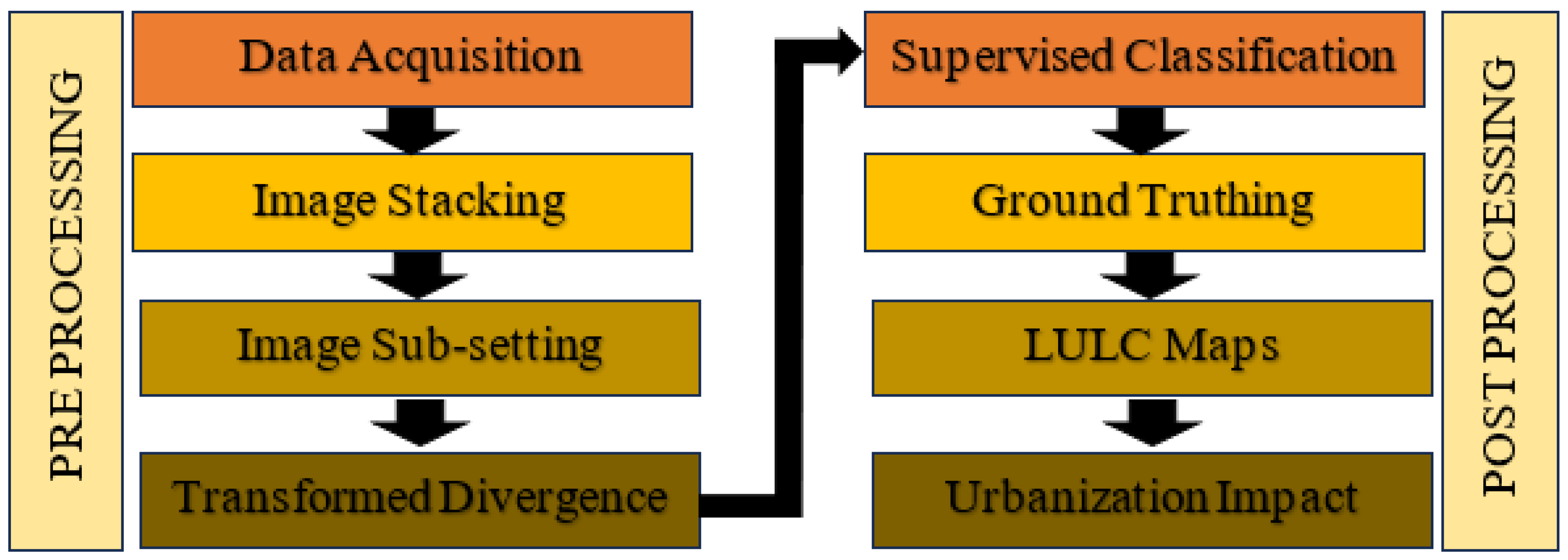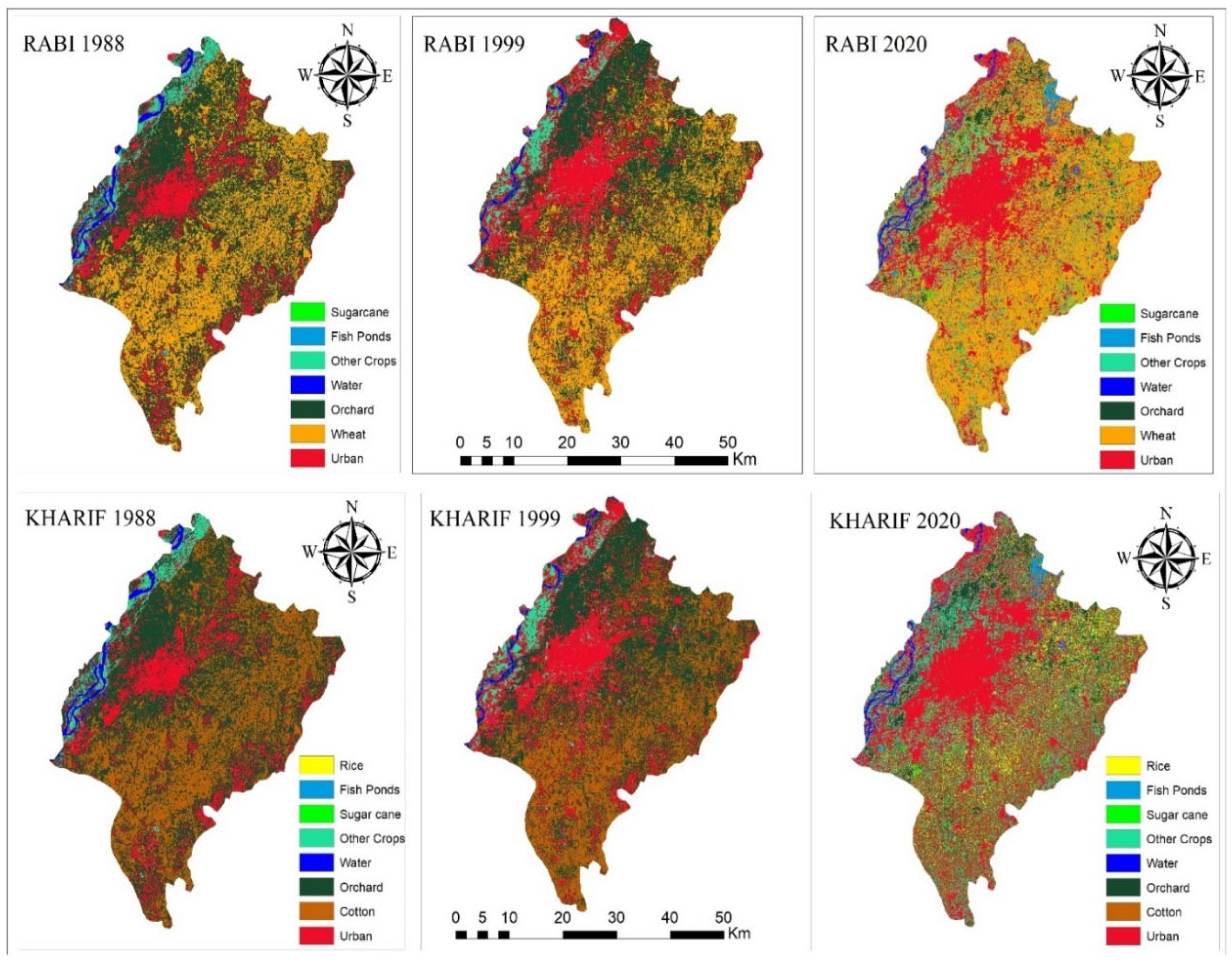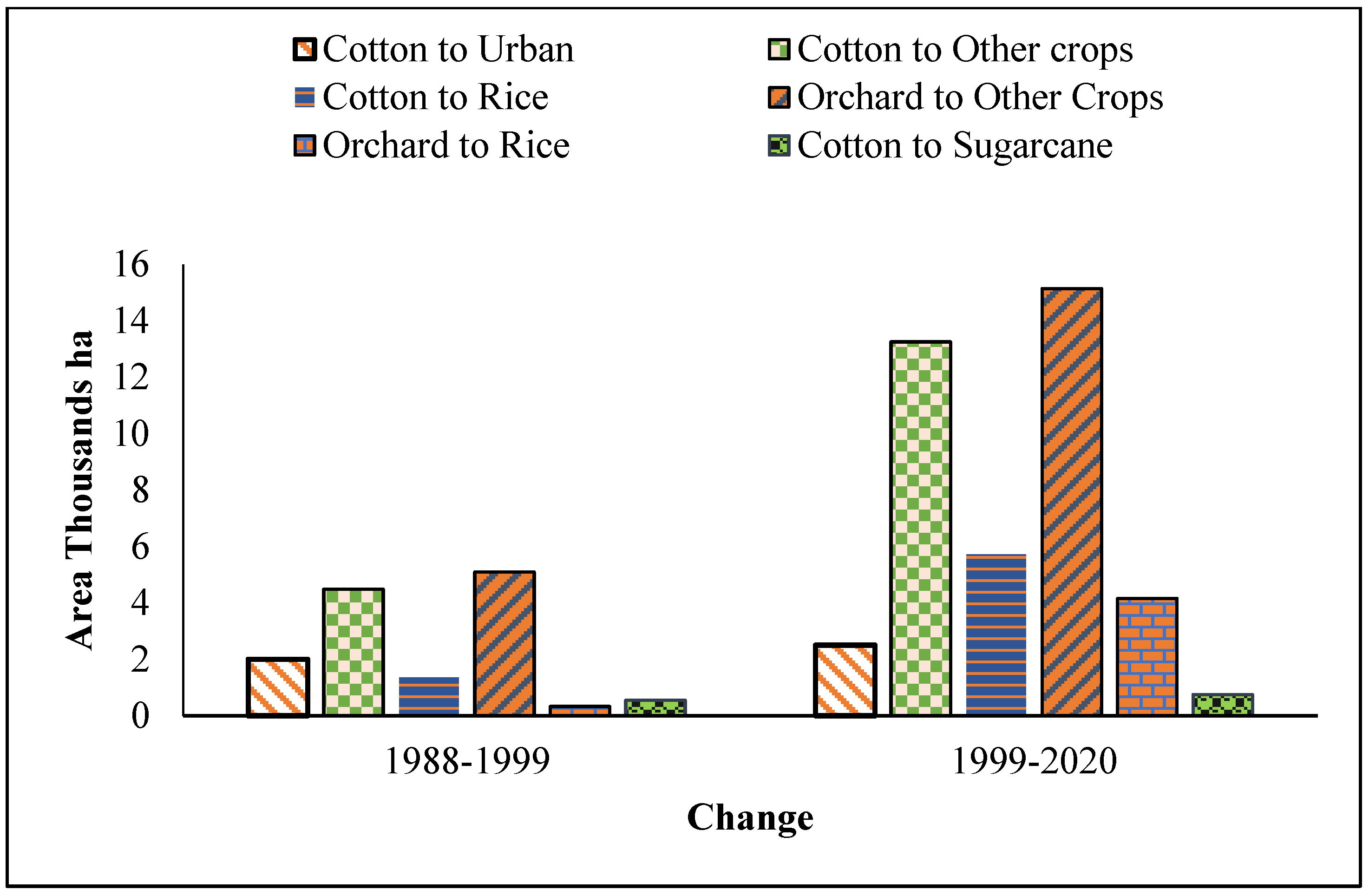Land Use Land Cover (LULC) Mapping for Assessment of Urbanization Impacts on Cropping Patterns and Water Availability in Multan, Pakistan
Abstract
1. Introduction
2. Study Area
3. Materials and Methods
3.1. Cropping Pattern
3.2. Data Acquisition
3.3. Image Classification and Interpolation
3.4. Accuracy Assessment for Land Use/Land Cover Maps
3.5. Water Availability and Canal Performance Assessment
4. Results
4.1. Change in Cropping Pattern
4.2. Ground Truthing and Accuracy Assessment
4.3. Change in Net Irrigation Water Availability
5. Discussion
6. Conclusions
Author Contributions
Funding
Data Availability Statement
Conflicts of Interest
References
- Khan, R.; Li, H.; Afzal, Z.; Basir, M.; Arif, M.; Hassan, W. Monitoring Subsidence in Urban Area by PSInSAR: A Case Study of Abbottabad City, Northern Pakistan. Remote Sens. 2021, 13, 1651. [Google Scholar] [CrossRef]
- Lebu, S.; Lee, A.; Salzberg, A.; Bauza, V. Adaptive Strategies to Enhance Water Security and Resilience in Low-and Middle-Income Countries: A Critical Review. Sci. Total Environ. 2024, 925, 171520. [Google Scholar] [CrossRef] [PubMed]
- Azizi, M.A.; Leandro, J. Factors Affecting Transboundary Water Disputes: Nile, Indus, and Euphrates–Tigris River Basins. Water 2025, 17, 525. [Google Scholar] [CrossRef]
- Aslam, R.W.; Shu, H.; Yaseen, A. Monitoring the Population Change and Urban Growth of Four Major Pakistan Cities through Spatial Analysis of Open Source Data. Ann. GIS 2023, 29, 355–367. [Google Scholar] [CrossRef]
- Alam, M.J.B.; Rahman, M.H.; Khan, S.; Munna, G.M. Unplanned Urbanization: Assessment through Calculation of Environmental Degradation Index. Int. J. Environ. Sci. Technol. 2006, 3, 119–130. [Google Scholar] [CrossRef]
- Governament of Pakistan, Agricultural Census 2010. Statistics Division; Agricultural Census Organization: Lahore, Pakistan, 2012; Volume 59.
- Putra, D.P.E.; Baier, K. Impact of Urbanization on Groundwater Recharge-The Example of the Indonesian Million City Yogyakarta. In Proceedings of the UN Habitat-United Nations Settlement Programs: Fourth session of the World Urban Forum, Nanjing, China, 3–6 November 2008. [Google Scholar]
- Mangi, M.Y.; Yue, Z.; Kalwar, S.; Ali Lashari, Z. Comparative Analysis of Urban Development Trends of Beijing and Karachi Metropolitan Areas. Sustainability 2020, 12, 451. [Google Scholar] [CrossRef]
- Beckers, V.; Poelmans, L.; Van Rompaey, A.; Dendoncker, N. The Impact of Urbanization on Agricultural Dynamics: A Case Study in Belgium. J. Land. Use Sci. 2020, 15, 626–643. [Google Scholar] [CrossRef]
- Bo Del, A.; Bignami, D.F.; Bruno, F.; Cardinale, M.V.; Perego, S. An Experience of Urban Transformation in Multan-Pakistani Punjab. In Regeneration of the Built Environment from a Circular Economy Perspective; Springer: Berlin/Heidelberg, Germany, 2020. [Google Scholar]
- Hussain, S.; Mubeen, M.; Akram, W.; Ahmad, A.; Habib-ur-Rahman, M.; Ghaffar, A.; Amin, A.; Awais, M.; Farid, H.U.; Farooq, A.; et al. Study of Land Cover/Land Use Changes Using RS and GIS: A Case Study of Multan District, Pakistan. Environ. Monit. Assess. 2020, 192, 2. [Google Scholar] [CrossRef]
- Mahlayeye, M.; Darvishzadeh, R.; Nelson, A. Cropping Patterns of Annual Crops: A Remote Sensing Review. Remote Sens. 2022, 14, 2404. [Google Scholar] [CrossRef]
- Ozesmi, S.L.; Bauer, M.E. Satellite Remote Sensing of Wetlands. Wetl. Ecol. Manag. 2002, 10, 381–402. [Google Scholar] [CrossRef]
- Zoungrana, B.J.; Conrad, C.; Thiel, M.; Amekudzi, L.K.; Da, E.D. MODIS NDVI Trends and Fractional Land Cover Change for Improved Assessments of Vegetation Degradation in Burkina Faso, West Africa. J. Arid. Environ. 2018, 153, 66–75. [Google Scholar] [CrossRef]
- Hu, Y.; Raza, A.; Syed, N.R.; Acharki, S.; Ray, R.L.; Hussain, S.; Dehghanisanij, H.; Zubair, M.; Elbeltagi, A. Land Use/Land Cover Change Detection and NDVI Estimation in Pakistan’s Southern Punjab Province. Sustainability 2023, 15, 3572. [Google Scholar] [CrossRef]
- Seyam, M.M.H.; Haque, M.R.; Rahman, M.M. Identifying the Land Use Land Cover (LULC) Changes Using Remote Sensing and GIS Approach: A Case Study at Bhaluka in Mymensingh, Bangladesh. Case Stud. Chem. Environ. Eng. 2023, 7, 100293. [Google Scholar] [CrossRef]
- Tahir, Z.; Haseeb, M.; Mahmood, S.A.; Batool, S.; Abdullah-Al-Wadud, M.; Ullah, S.; Tariq, A. Predicting Land Use and Land Cover Changes for Sustainable Land Management Using CA-Markov Modelling and GIS Techniques. Sci. Rep. 2025, 15, 3271. [Google Scholar] [CrossRef]
- Aghajani, H.; Sarkari, F.; Fattahi Moghaddam, M. Predicting Land Use/Land Cover Changes Using CA-Markov and LCM Models in the Metropolitan Area of Mashhad, Iran. Model. Earth Syst. Environ. 2024, 10, 7079–7096. [Google Scholar] [CrossRef]
- Rawat, J.S.; Kumar, M. Monitoring Land Use/Cover Change Using Remote Sensing and GIS Techniques: A Case Study of Hawalbagh Block, District Almora, Uttarakhand, India. Egypt. J. Remote Sens. Sp. Sci. 2015, 18, 77–84. [Google Scholar] [CrossRef]
- Rawat, J.S.; Biswas, V.; Kumar, M. Changes in Land Use/Cover Using Geospatial Techniques: A Case Study of Ramnagar Town Area, District Nainital, Uttarakhand, India. Egypt. J. Remote Sens. Sp. Sci. 2013, 16, 111–117. [Google Scholar] [CrossRef]
- Fan, Y.; Gao, Z.; Wang, S.; Chen, H.; Liu, J. Evaluation of the Water Allocation and Delivery Performance of Jiamakou Irrigation Scheme, Shanxi, China. Water 2018, 10, 654. [Google Scholar] [CrossRef]
- Governament of Pakistan, Pakistan Demograhic Survey-2020. Ministry of Planning, Development and Special Initiatives; Pakistan Beureau of Statistics: Islamabad, Pakistan, 2020; Volume 162.
- Gao, J.; Liu, Y. Determination of Land Degradation Causes in Tongyu County, Northeast China via Land Cover Change Detection. Int. J. Appl. Earth Obs. Geoinf. 2010, 12, 9–16. [Google Scholar] [CrossRef]
- Naeem, M.; Farid, H.U.; Madni, M.A.; Ahsen, R.; Khan, Z.M.; Dilshad, A.; Shahzad, H. Remotely Sensed Image Interpretation for Assessment of Land Use Land Cover Changes and Settlement Impact on Allocated Irrigation Water in Multan, Pakistan. Environ. Monit. Assess. 2022, 194, 98. [Google Scholar] [CrossRef]
- Usman, M.; Liedl, R.; Shahid, M.A.; Abbas, A. Land use/land cover Classification and its Change Detection Using Multi-temporal MODIS NDVI. J. Geographical sciences. 2015, 25, 1479–1506. [Google Scholar] [CrossRef]
- Tesfaye, W.; Elias, E.; Warkineh, B.; Tekalign, M.; Abebe, G. Modeling of Land Use and Land Cover Changes Using Google Earth Engine and Machine Learning Approach: Implications for Landscape Management. Environ. Syst. Res. 2024, 13, 31. [Google Scholar] [CrossRef]
- Aryal, J.; Sitaula, C.; Frery, A.C. Land Use and Land Cover (LULC) Performance Modeling Using Machine Learning Algorithms: A Case Study of the City of Melbourne, Australia. Sci. Rep. 2023, 13, 13510. [Google Scholar] [CrossRef] [PubMed]
- Mohsin, M.; Mehmood, S.; Jamal, F.; Anwer, M.M. Modeling and Forecasting of Declining Area and Production of Mango Orchards in District Bahawalpur, Pakistan. J. Agric. Res. 2021, 59, 197–212. [Google Scholar]
- Yagi, H.; Garrod, G. The Future of Agriculture in the Shrinking Suburbs: The Impact of Real Estate Income and Housing Costs. Land. Use Policy 2018, 76, 812–822. [Google Scholar] [CrossRef]
- Wrzesiński, D.; Sobkowiak, L. Transformation of the Flow Regime of a Large Allochthonous River in Central Europe—An Example of the Vistula River in Poland. Water 2020, 12, 507. [Google Scholar] [CrossRef]
- Arshad, A.; Raza, M.A.; Zhang, Y.; Zhang, L.; Wang, X.; Ahmed, M.; Habib-ur-rehman, M. Impact of Climate Warming on Cotton Growth and Yields in China and Pakistan: A Regional Perspective. Agriculture 2021, 11, 97. [Google Scholar] [CrossRef]
- Swain, B.B.; Teufel, N. The Impact of Urbanisation on Crop–Livestock Farming System: A Comparative Case Study of India and Bangladesh. J. Soc. Econ. Dev. 2017, 19, 161–180. [Google Scholar] [CrossRef]
- Anwar, M.M.; Breuste, J.H.; Ahmad, A.; Aziz, A.; Aldosari, A.A. Quantifying the Impacts of Urbanization on Urban Agriculture and Food Security in the Megacity Lahore, Pakistan. Sustainability 2023, 15, 12143. [Google Scholar] [CrossRef]
- Braamhaar, D.J.M.; van der Lee, J.; Bebe, B.O.; Oosting, S.J. From Rural to Urban: Exploring Livestock Farming Practices in Urbanizing Landscapes. Agric. Syst. 2025, 225, 104297. [Google Scholar] [CrossRef]
- Huang, J.; Ridoutt, B.G.; ZHANG, H.; CHEN, F. Cropping Pattern Modifications Change Water Resource Demands in the Beijing Metropolitan Area. J. Integr. Agric. 2012, 11, 1914–1923. [Google Scholar] [CrossRef]
- Shahzad, M.; Iftikhar, M.; Shahbaz, B.; Wajid, S.A. Impact of Cropping Pattern Shift on Livelihood Assets of the Farmers in Punjab, Pakistan. Int. J. Agric. Ext. 2021, 8, 189–197. [Google Scholar] [CrossRef]
- Fader, M.; Shi, S.; von Bloh, W.; Bondeau, A.; Cramer, W. Mediterranean Irrigation under Climate Change: More Efficient Irrigation Needed to Compensate for Increases in Irrigation Water Requirements. Hydrol. Earth Syst. Sci. 2016, 20, 953–973. [Google Scholar] [CrossRef]
- Velasco-Muñoz, J.F.; Aznar-Sánchez, J.A.; Batlles-delaFuente, A.; Fidelibus, M.D. Sustainable Irrigation in Agriculture: An Analysis of Global Research. Water 2019, 11, 1758. [Google Scholar] [CrossRef]
- Abdi, A.H.; Mohamed, A.A.; Mohamed, F.H. Enhancing Food Security in Sub-Saharan Africa: Investigating the Role of Environmental Degradation, Food Prices, and Institutional Quality. J. Agric. Food Res. 2024, 17, 101241. [Google Scholar] [CrossRef]
- Yan, T.; Wang, J.; Huang, J. Urbanization, Agricultural Water Use, and Regional and National Crop Production in China. Ecol. Modell. 2015, 318, 226–235. [Google Scholar] [CrossRef]





| Type and Source | Data Components | Description/Details |
|---|---|---|
| Satellite data (glovis.usgs.gov) | LANDSAT 4-5 Thematic Mapper (TM) LANDSAT 8 Operational Land Imager (OLI) | 30 m resolution, 7 spectral bands, for year 1988 and 1999 30 m resolution, 11 spectral bands for the year 2020. |
| Metrological data (Pakistan Metrological Department, Islamabad) | Precipitation, Temperature, Wind Speed, Humidity and Sunshine Hours | For the year 1988 to 2020 |
| Agriculture data (Agriculture Department) Irrigation data (Irrigation Department) | Agricultural Census Data, Crop Calendar, Crop Coefficient, and Crop Rotation Canal Flow Data, Canal Command Area | For the years 1988, 1999 and 2020 August to November, 2020 |
| Distributary | Code | Location | Type * | Assig. Discharge (m3/s) | Command Area Change due to Urbanization (ha) | ||
|---|---|---|---|---|---|---|---|
| 1988 | 1999 | 2020 | |||||
| Khadil | 16 | Head | NP | 1.84 | 3565 | 2865 | 1985 |
| Multan | 22 | Middle | NP | 1.30 | 2070 | 1070 | 785 |
| Buch | 31 | Tail | NP | 1.1 | 1953 | 1800 | 1585 |
| Jalwala | 4 | Head | P | 1.37 | 4434 | 3853 | 3658 |
| Piran Ghaib | 11 | Middle | P | 0.11 | 415 | 363 | 250 |
| Khoja Minor | 45 | Tail | P | 0.37 | 1600 | 1485 | 1185 |
| Rashida | 26 | Head | P | 0.91 | 4223 | 3585 | 2850 |
| Tatepur Minor | 33 | Middle | P | 0.58 | 2479 | 2400 | 2138 |
| Gulzar Minor | 43 | Tail | P | 0.41 | 1636 | 1485 | 1240 |
| LULC Type | Area Distribution (ha) | Change Detection (%) | ||||
|---|---|---|---|---|---|---|
| 1988 | 1999 | 2020 | 1988–1999 | 1999–2020 | 1988–2020 | |
| Urban | 31,200 | 44,400 | 69,800 | 42.3 | 57.2 | 123.7 |
| River | 3000 | 1600 | 1600 | −46.7 | 0.0 | −46.7 |
| Fishponds | 0 | 1400 | 2900 | - | 107.1 | - |
| Sugarcane | 568 | 1123 | 3240 | 83.3 | 190.9 | 433.3 |
| Rice | 1547 | 3228 | 13,122 | 100.0 | 309.4 | 718.8 |
| Wheat | 62,200 | 57,300 | 79,200 | −7.9 | 38.2 | 27.3 |
| Cotton | 70,676 | 62,196 | 40,791 | −12.4 | −34.4 | −42.5 |
| Other Crops (R) | 19,232 | 23,577 | 26,831 | 22.3 | 13.6 | 38.9 |
| Other Crops (K) | 20,192 | 29,687 | 58,032 | 47.0 | 95.3 | 187.1 |
| Orchard | 82,440 | 66,000 | 14,600 | −19.9 | −77.9 | −82.3 |
| Land Types | Change Detection in Rabi Season (%) | Land Types | Change Detection in Kharif Season (%) | ||
|---|---|---|---|---|---|
| 1988–1999 | 2000–2020 | 1988–1999 | 2000–2020 | ||
| Orchard to Urban | 13.7 | 34.8 | Cotton to Urban | 2.8 | 3.9 |
| Orchard to Wheat | 0 | 33.2 | Cotton to Other Crops | 6.3 | 21.3 |
| Orchard to Fishponds | 0 | 2.1 | Cotton to Rice | 2.0 | 9.3 |
| Orchard to Other Crops | 1.7 | 5.0 | Orchard to Other Crops | 6.2 | 23 |
| Orchard to Sugarcane | 0 | 3.0 | Orchard to Rice | 0.4 | 6.3 |
| Wheat to Sugarcane | 1.0 | 0.0 | Cotton to Sugarcane | 0.8 | 1.2 |
| Wheat to Other Crops | 4.8 | 0.0 | - | - | - |
| Wheat to Fishponds | 2.1 | 0.0 | - | - | - |
| LULC Classes | Producer’s Accuracy | User’s Accuracy | ||||||
|---|---|---|---|---|---|---|---|---|
| 1988 | 1999 | 2020 | Avg. | 1988 | 1999 | 2020 | Avg. | |
| Urban | 84 | 86 | 88 | 86 | 90 | 86 | 84 | 87 |
| Rivers | 82 | 90 | 85 | 86 | 84 | 79 | 85 | 83 |
| Fishponds | 86 | 78 | 79 | 81 | 80 | 82 | 86 | 83 |
| Orchards | 84 | 84 | 87 | 85 | 92 | 75 | 89 | 85 |
| Wheat | 83.1 | 84.5 | 88.8 | 85.5 | 84.2 | 78.6 | 86 | 82.9 |
| Sugarcane (Rabi) | 83.5 | 79.5 | 80.7 | 81.2 | 79.5 | 81.6 | 85.7 | 82.3 |
| Other crops (Rabi) | 81.2 | 80.5 | 86 | 82.6 | 83.7 | 82.8 | 67.5 | 78 |
| Cotton | 82 | 83.1 | 84.8 | 83.3 | 81.9 | 78.2 | 81.5 | 80.5 |
| Rice | 81.9 | 79.2 | 80.7 | 80.6 | 87.6 | 81.6 | 85.7 | 84.9 |
| Sugarcane (Kharif) | 83.1 | 81.9 | 86.4 | 83.8 | 78.7 | 85.3 | 80.5 | 81.5 |
| Other crops (Kharif) | 80.6 | 82.6 | 80.9 | 81.4 | 78.1 | 82.8 | 79.5 | 80.1 |
| Year | Rabi Season | Kharif Season | ||||||
|---|---|---|---|---|---|---|---|---|
| Avg. Producer’s Accuracy | Avg. User’s Accuracy | Overall Accuracy | K | Avg. Producer’s Accuracy | Avg. User’s Accuracy | Overall Accuracy | K | |
| 1988 | 86.1 | 86.4 | 88.5 | 0.76 | 85.3 | 81.8 | 87.0 | 0.82 |
| 1999 | 81.3 | 83.0 | 85.4 | 0.78 | 84.4 | 82.8 | 90.2 | 0.85 |
| 2020 | 85.1 | 80.1 | 86.0 | 0.83 | 84.1 | 84.0 | 88.6 | 0.79 |
| Average | 82.2 | 83.2 | 86.6 | 0.79 | 84.6 | 83.5 | 88.60 | 0.82 |
| Distributary | Change in Water Allowance (m3/s)/1000 ha) | ||
|---|---|---|---|
| 1988 | 1999 | 2020 | |
| Khadil | 0.516 | 0.642 | 0.92 |
| Multan | 0.628 | 1.21 | 1.65 |
| Buch | 0.563 | 0.611 | 0.694 |
| Jalwala | 0.31 | 0.356 | 0.375 |
| Piran Ghaib | 0.265 | 0.303 | 0.44 |
| Khoja Minor | 0.231 | 0.249 | 0.312 |
| Rashida | 0.215 | 0.254 | 0.319 |
| Tatepur Minor | 0.234 | 0.242 | 0.271 |
| Gulzar Minor | 0.251 | 0.276 | 0.331 |
Disclaimer/Publisher’s Note: The statements, opinions and data contained in all publications are solely those of the individual author(s) and contributor(s) and not of MDPI and/or the editor(s). MDPI and/or the editor(s) disclaim responsibility for any injury to people or property resulting from any ideas, methods, instructions or products referred to in the content. |
© 2025 by the authors. Licensee MDPI, Basel, Switzerland. This article is an open access article distributed under the terms and conditions of the Creative Commons Attribution (CC BY) license (https://creativecommons.org/licenses/by/4.0/).
Share and Cite
Zakariya, K.M.; Sarwar, T.; Farid, H.U.; Albano, R.; Inam, M.A.; Shoaib, M.; Ahmad, A.; Ahmad, M. Land Use Land Cover (LULC) Mapping for Assessment of Urbanization Impacts on Cropping Patterns and Water Availability in Multan, Pakistan. Earth 2025, 6, 79. https://doi.org/10.3390/earth6030079
Zakariya KM, Sarwar T, Farid HU, Albano R, Inam MA, Shoaib M, Ahmad A, Ahmad M. Land Use Land Cover (LULC) Mapping for Assessment of Urbanization Impacts on Cropping Patterns and Water Availability in Multan, Pakistan. Earth. 2025; 6(3):79. https://doi.org/10.3390/earth6030079
Chicago/Turabian StyleZakariya, Khawaja Muhammad, Tahir Sarwar, Hafiz Umar Farid, Raffaele Albano, Muhammad Azhar Inam, Muhammad Shoaib, Abrar Ahmad, and Matlob Ahmad. 2025. "Land Use Land Cover (LULC) Mapping for Assessment of Urbanization Impacts on Cropping Patterns and Water Availability in Multan, Pakistan" Earth 6, no. 3: 79. https://doi.org/10.3390/earth6030079
APA StyleZakariya, K. M., Sarwar, T., Farid, H. U., Albano, R., Inam, M. A., Shoaib, M., Ahmad, A., & Ahmad, M. (2025). Land Use Land Cover (LULC) Mapping for Assessment of Urbanization Impacts on Cropping Patterns and Water Availability in Multan, Pakistan. Earth, 6(3), 79. https://doi.org/10.3390/earth6030079








